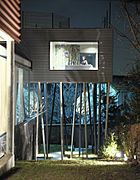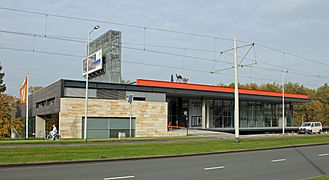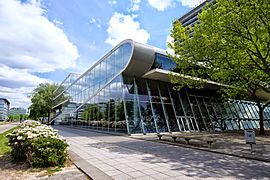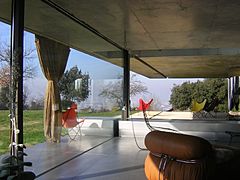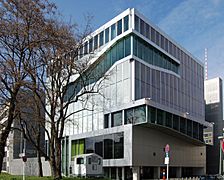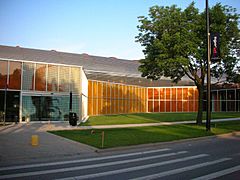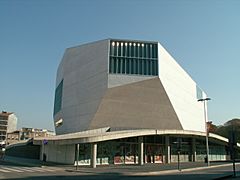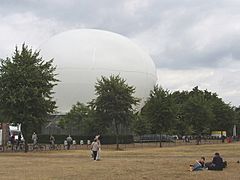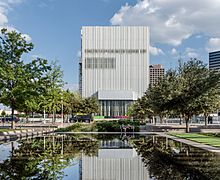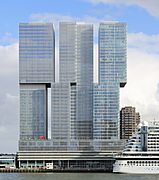Rem Koolhaas facts for kids
Quick facts for kids
Rem Koolhaas
|
|
|---|---|

Koolhaas in 2013
|
|
| Born |
Remment Lucas Koolhaas
17 November 1944 Rotterdam, Netherlands
|
| Alma mater | Architectural Association School of Architecture Cornell University |
| Occupation | Architect Architectural theorist Urbanist |
| Awards | Pritzker Prize (2000) Praemium Imperiale (2003) Royal Gold Medal (2004) Leone d'oro alla carriera (2010) Rolf Schock Prize (2022) |
| Practice | Office for Metropolitan Architecture |
| Buildings | Casa da Música in Porto De Rotterdam Seattle Central Library Netherlands Embassy Berlin China Central Television Headquarters Qatar National Library |
| Projects | Delirious New York, S,M,L,XL Volume Magazine |
Remment Lucas Koolhaas (born 17 November 1944) is a famous Dutch architect. He is also an architectural thinker and urban planner. He teaches architecture at Harvard University.
Many people see him as one of the most important architectural thinkers of his time. In 2000, Rem Koolhaas won the Pritzker Prize. This is one of the highest awards an architect can receive. In 2008, Time magazine named him one of The World's Most Influential People.
Contents
Early Life and Education
Remment Koolhaas was born on November 17, 1944, in Rotterdam, Netherlands. His father, Anton Koolhaas, was a writer and film critic. His grandfather, Dirk Roosenburg, was also a modern architect.
When Rem was young, his family lived in different cities. They lived in Rotterdam, Amsterdam, and Jakarta, Indonesia. His father supported Indonesia's fight for independence. Because of this, his family moved to Jakarta for three years when Rem was eight. He remembers this time as very important.
Koolhaas started as a journalist at age 19. Then, in 1968, he began studying architecture. He studied at the Architectural Association School of Architecture in London. Later, he continued his studies at Cornell University in New York.
Starting His Architecture Career
Koolhaas became well-known after he started OMA in 1975. He founded OMA with other architects like Elia Zenghelis and Madelon Vriesendorp. Zaha Hadid, who later became a famous architect, also joined them.
One of their early projects showed their unique style. It was for the Venice Biennale in 1980. While other architects used old styles, OMA's design was different. It did not use historical references.
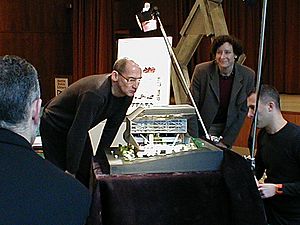
Some of their early designs were not built. These included plans for the Parc de la Villette in Paris (1982). Another was a residence for the Prime Minister of Ireland (1979). The Kunsthal in Rotterdam (1992) was one of their first built projects.
These designs used ideas from Koolhaas's book, Delirious New York. He wrote this book in 1978. It explored how cities like New York work.
Ideas About Architecture
Koolhaas has written several important books about architecture. These books share his ideas about how cities and buildings should be designed.
Delirious New York
Koolhaas's book Delirious New York was very important for his career. In this book, he looked at the exciting and sometimes random nature of city life. He described the city as a powerful "machine" that is always changing.
He also thought about how buildings are designed based on their "program." The program is what a building is used for. For example, a house has a program for living, and a school for learning. Koolhaas explored how modern architecture changed this idea. He suggested that buildings could have unexpected uses. For instance, he once thought about putting hospital units for homeless people into the Seattle Public Library.

Studying Cities and Shopping
Koolhaas also led a project at Harvard University called "Project on the City." This project studied different types of cities. They looked at places like Lagos in Nigeria. They also studied how shopping affects cities.
These studies explored how cities grow and change. They looked at how shopping centers and airports become important parts of city life. Koolhaas often uses these observations in his building designs. He calls this the "culture of congestion."
In 2003, Koolhaas published a book called Content. This book showed many projects by OMA. It included designs for Prada stores and the Seattle Public Library.
Volume Magazine
In 2005, Rem Koolhaas helped start Volume Magazine. This magazine is a place for new ideas about space and culture. It looks beyond just building design. It explores how architecture connects with global views and social structures. The magazine aims to find new possibilities in design and urban planning.
Famous Buildings and Projects
Koolhaas and OMA have designed many well-known buildings around the world.
Architecture and Fashion
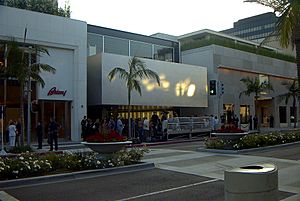
Koolhaas designed stores for the fashion brand Prada. These stores were not just for selling clothes. They were also designed to be exciting spaces. For example, the Prada store in Beverly Hills has a large central staircase. This staircase is a place for shoppers to see and be seen.
The Prada store on Broadway in New York was also special. It used to be a museum. Koolhaas kept some of the museum's feeling in his design. This showed that the store was also a cultural space. The Broadway Prada store opened in December 2001.
Buildings of the 21st Century
Two of OMA's most famous projects in the 21st century are in China. These are the Central China Television Headquarters Building in Beijing and the new building for the Shenzhen Stock Exchange.
For the CCTV Headquarters in Beijing (2009), Koolhaas designed a unique building. It is not a typical tall skyscraper. He called it a "horizontal skyscraper." The building connects many different departments. It also has paths for the public to walk through. This allows people to see parts of the TV production process.
In February 2020, his exhibition Countryside, The Future opened at the Guggenheim Museum in New York City. The exhibition explored ideas about rural areas and their future.
Personal Life
Rem Koolhaas was married to Madelon Vriesendorp, an artist. They have two children, Charlie and Tomas. Charlie is a photographer, and Tomas is a filmmaker. Koolhaas and Vriesendorp divorced in 2012. His current partner is Petra Blaisse, who designs interiors and landscapes. They have known each other since 1986.
Selected Projects
- Villa dall’Ava, (Saint-Cloud, 1991)
- Nexus World Housing (Fukuoka, 1991)
- Kunsthal (Rotterdam, 1992)
- Euralille (Lille, 1994)
- Educatorium (Utrecht, 1995)
- Maison à Bordeaux (Bordeaux, 1998)
- Embassy of the Netherlands (Berlin, 2003)
- McCormick Tribune Campus Center (Chicago, 2003)
- Seoul National University Museum of Art (Seoul, 2005)
- Seattle Central Library (Seattle, 2005)
- Casa da Música (Porto, 2005)
- Dee and Charles Wyly Theater (Dallas, 2009)
- CCTV Headquarters, (Beijing, 2012)
- De Rotterdam (Rotterdam, 2013)
- Garage Museum of Contemporary Art (Moscow, 2014)
- Qatar National Library (Doha, 2017)
- Taipei Performing Arts Center (Taipei, 2022)
Gallery
-
Kunsthal, Rotterdam, The Netherlands, OMA
-
Educatorium, Utrecht, The Netherlands, OMA
-
Embassy of the Netherlands, Berlin, Germany, OMA
-
Seattle Central Library, Seattle, United States, OMA
-
Casa da Música, Porto, Portugal, OMA
-
Dee and Charles Wyly Theater, Dallas, US, OMA
-
De Rotterdam, Rotterdam, The Netherlands, OMA
See also
 In Spanish: Rem Koolhaas para niños
In Spanish: Rem Koolhaas para niños
- Contemporary architecture
- World Architecture Survey
- List of architects
- Koolhaas Houselife



